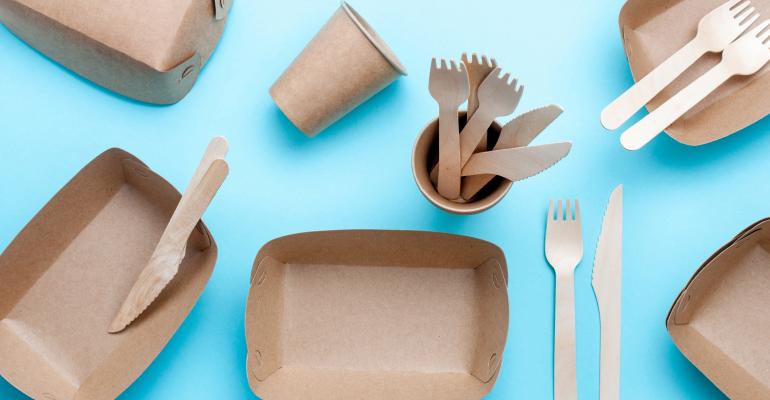For years, restaurants have been buying expensive compostable takeout packaging, hoping it was a more planet-friendly solution to single-use plastic.
Sadly, few cities have the infrastructure to collect compostable foodservice packaging. Even in jurisdictions where organic food waste is collected from restaurants, compost facilities tend to say no to foodservice packaging — even plant-based containers made from things like sugar beets or cornstarch.
As a result, that costly compostable foodware likely ends up in a landfill. And, because compostables require certain conditions to break down, those containers contribute to growing mountains of waste — just like the plastic containers they were meant to replace.
But a group of powerful stakeholders, including McDonald’s, Starbucks and Pepsi, are joining forces in an effort to find a solution.
A new Composting Consortium launched this week with the goal of creating a roadmap for a composting infrastructure that will allow for the collection of organic foodwaste alongside compostable packaging to ultimately create a product —compost — that will nurture soil and cut greenhouse gas emissions.
Launched by the Center for the Circular Economy at Closed Loop Partners, the Composting Consortium includes founding partners PepsiCo and the NextGen Consortium, which also includes Starbucks and McDonald’s, as well as supporting partners like Wendy’s.
It also includes big manufacturers, like Colgate-Palmolive, The Kraft Heinz Company and Mars Inc., as well as retailers, like Target. Some of these companies have their own sustainability goals. Both PepsiCo and Kraft, for example, have pledged to make all packaging recyclable, reusable or compostable by 2025.
“Knowing how important packaging is — to protect the safety, quality and freshness of our products, extend their shelf life and limit food waste — we understand how critical it is to advance holistic solutions that prevent packaging from becoming waste,” said Burgess Davis, PepsiCo’s vice president global sustainable packaging and sustainability strategy, in a statement. “This unprecedented collaboration with the NextGen Consortium and leading foodservice and consumer goods brands can forge a clear path forward for compostable packaging, strengthening it as a viable alternative to plastics and preventing it from going to waste.”
The NextGen Consortium has been on a quest to find better foodservice packaging solutions overall, and is looking at things like recycling and reusable packaging.
This new Composting Coalition effort piggybacks on that, bringing in other players like the Biodegradable Products Institute, which certifies packaging as compostable, and the U.S. Plastics Pact, which has been working on recycling solutions. Also joining is the Compost Manufacturing Alliance, companies like Google, and nonprofits like the food-waste-focused ReFed and the planet-protecting World Wildlife Fund.
“There is increasing awareness of the climate risks posed by food scraps being wasted in landfills, alongside the challenges of waste from packaging that is not getting recycled. This is driving broad support for a change to the status quo, including a desire for widespread access to composting and innovative compostable packaging that can be composted with food,” said Rhodes Yepsen, executive director of the Biodegradable Products Institute, in a statement.
The goal is to remove the barriers for compostable foodware — a product line that is projected to grow 17% between 2020 and 2027 — making such products a more viable alternative to single-use plastics.
“One problem is there is no widely available composting infrastructure,” said Kate Daly, managing director of the Center for the Circular Economy at Closed Loop Partners, in an interview. “We saw that disconnect and that sense of urgency around it. So we wanted to bring together key players and stakeholders to address that misalignment.”
One of the primary barriers for compostables is contamination, she said.
Because so many compostable cups and bowls are designed to mimic plastic, consumers are likely to confuse the two, throwing plastic containers in the composting bin, and throwing compostable containers in the recycling bins — contaminating both waste streams.
“Most people aren’t going to put those in the right bin, even if the right bin existed,” said Daly.
In addition, some compostable containers are lined with potentially toxic per- and polyfluoroalkyl substances, or PFAS, sometimes called “forever chemicals,” which the federal Environmental Protection Agency is looking to regulate.
The Composting Consortium will look at everything from the type of materials used in compostable packaging, to how such packaging should be labeled, recovered and converted into a useful, and potentially lucrative, product — and fundamentally how all of it can benefit the planet, rather than cause harm. Best practices will be identified and a toolkit developed, she said.
“The interesting thing about this challenge is that you can’t just solve one bottleneck in the chain. You have to go after all of them,” said Daly. “There are no easy answers right now. It’s a complex and fragmented universe when it comes to foodservice and packaging.”
Daly hopes more players in the restaurant industry will join in to be a part of finding the right solutions.
“This is a call to action for more brands to join us,” she said. “We do think restaurants and other brands will see this as a good opportunity, first, for education around a complex issue, and for action around where capital can be most catalytic.”
Contact Lisa Jennings at [email protected]
Follow her on Twitter: @livetodineout

